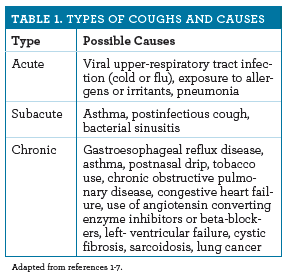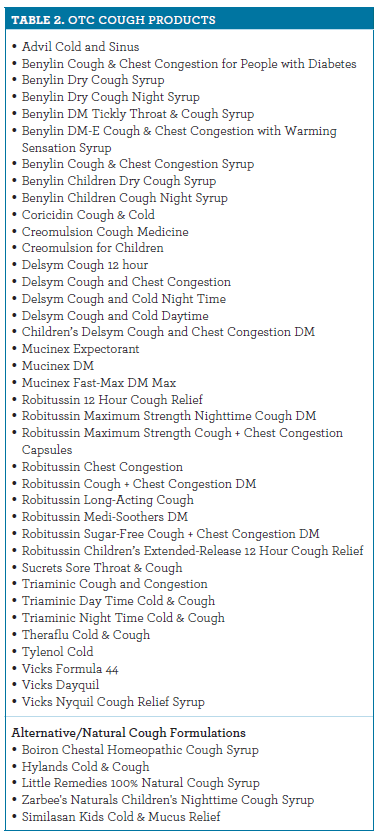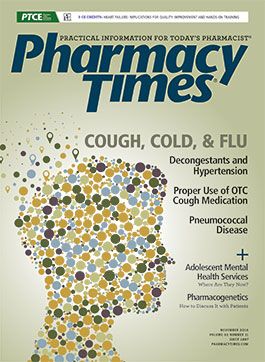Publication
Article
Pharmacy Times
Proper Use of OTC Cough Medications: Back to the Basics
Author(s):
Cold and flu season is the time of the year when pharmacists are more likely to see patients scanning the pharmacy shelves in search of the perfect remedy to manage a cough.
Cold and flu season is the time of the year when pharmacists are more likely to see patients scanning the pharmacy shelves in search of the perfect remedy to manage a cough. Patients may be overwhelmed by the numerous OTC cough products, but pharmacists are in an ideal position to evaluate and aid patients in selecting a cough product for self-treatment, as well as to encourage patients to seek further medical care when warranted. Annually, consumers spend an estimated $4 billion on OTC medications for treating and managing coughs. In fact, cough is the most common symptom for which patients seek medical care.1 Additionally, cough is a common symptom for which patients pursue care at urgent care clinics and emergency departments.1
Cough can be classified as acute or chronic and can be due to exposure to irritants or allergens, certain medical conditions, or the use of certain medications (Table 11-7). Acute coughs typically last less than 3 weeks, subacute coughs last 3 to 8 weeks, and chronic coughs last more than 8 weeks.1-3 In addition, coughs can be described as productive or nonproductive. Although most coughs resolve on their own, some types of coughs, such as chronic coughs, can be annoying and have a negative impact on quality of life by interfering with sleep and causing exhaustion, musculoskeletal pain/discomfort, hoarseness, headaches, urinary incontinence, chest pain, and fatigue.1-5 Patients with chronic coughs should be evaluated to determine the cause of the cough and to rule out serious medical conditions.

OTC Cough Medications
The primary goals for self-treatment of cough are to eradicate the cough and prevent complications. Because treatment of cough is symptomatic, the underlying cause must be identified and treated.1-3 For self-treatment and management of cough, there are a plethora of OTC products, including oral antitussives, expectorants, and topical antitussives, which are available in a variety of dosage forms (Table 2). In addition, there are single-entity and combination products that contain a protussive agent and an antitussive agent.1,3

Expectorants (Protussives)
Guaifenesin is the only FDA-approved expectorant also known as a protussive agent. It is indicated for the symptomatic relief of acute ineffective, productive cough.1 Although the pharmacokinetics of guaifenesin are not well understood, this agent appears to be well absorbed after oral administration, with a half-life estimated to be about 1 hour.1 The use of guaifenesin is not associated with any known drug interactions and is generally well tolerated; however, rare adverse effects (AEs), such as dizziness, headache, rash, nausea, vomiting, and gastrointestinal upset, have been reported.1 Expectorants are available in various dosage forms, including liquids, syrups, granules, tablets, and liquid-filled capsules. Guaifenesin should not be used to treat chronic cough associated with chronic lower respiratory tract diseases, such as asthma, chronic obstructive pulmonary disease (COPD), emphysema, or smoker’s cough.1,3
Antitussives
The currently available FDA-approved OTC oral antitussives include codeine, dextromethorphan, and diphenhydramine in various dosage formulations to suit patient needs.1
Dextromethorphan
Most OTC cough suppressants contain dextromethorphan, which is indicated for suppressing nonproductive cough caused by chemical or mechanical respiratory tract irritation.1,3 Examples of dosage forms for dextromethorphan include syrups, liquids, suspensions, liquid filled gel caps, granules, and lozenges. Dextromethorphan is well absorbed after oral administration, with a 15- to 30-minute onset of action and a duration of effect of 3 to 6 hours.1 Although uncommon, AEs include nausea, drowsiness, vomiting, stomach discomfort, and constipation.1,3
According to the National Institute of Drug Abuse, dextromethorphan is one of the 2 most commonly abused cough medications, especially among adolescents. When taken in large quantities, the drug may produce euphoria and hallucinations.8 Abuse of dextromethorphan can impair motor function and cause numbness, nausea, vomiting, tachycardia, hypertension, an increase in body temperature, and a build-up of excess acid in the body.8 Efforts by many health care providers to increase awareness about dextromethorphan abuse have produced promising results. A June 2016 report from the Consumer Healthcare Products Association stated that the rates of dextromethorphan abuse have fallen more than 40% since 2010 due to the actions of a dextromethorphan abuse mitigation campaign.9,10
Diphenhydramine
Diphenhydramine is classified as a nonselective first-generation antihistamine with significant sedating and anticholinergic properties.1 Although approved by the FDA as an antitussive, it is not considered a first-line antitussive, but is found in many cold and allergy products, along with other ingredients.1 Diphenhydramine acts centrally in the medulla to increase cough threshold.1 It is indicated for the suppression of nonproductive cough caused by chemical or mechanical respiratory tract irritation.1,3 The most common AEs include drowsiness, respiratory depression, blurry vision, urinary retention, and dry mouth.1,3
Codeine
At antitussive dosages, codeine is classified as a Schedule 5 narcotic and is available without a prescription in many states.1 Codeine is indicated for the suppression of nonproductive cough caused by chemical or mechanical respiratory tract irritation.1 Codeine acts centrally on the medulla to increase the cough threshold and, when administered at antitussive doses, has low toxicity and little risk of addiction.1 The most common AEs of codeine at antitussive dosages include nausea, vomiting, sedation, dizziness, and constipation. The drug should be used with caution in individuals with asthma, COPD, respiratory depression, and drug addictions.1,3
Other Antitussives
Camphor and menthol, the only 2 FDA-approved topical antitussives, are found in ointments and inhalation form.1 Patients should be counseled on the proper use of these agents and directed to follow the manufacturer’s instructions. Menthol is also found in many throat lozenges for treating cough.1,3
End Note
Prior to recommending OTC cough products, pharmacists should ascertain whether self-treatment is appropriate and should always obtain patients’ allergy history, medical history, and current medication profile to check for potential drug interactions and contraindications. Pregnant and lactating women and those with chronic medical conditions should always consult their primary health care provider before using any OTC cough medication.
During counseling, patients should be reminded to read labels prior to using products and to check ingredients, especially if using multiple products, to avoid therapeutic duplications or excessive dosing. It is also imperative for patients to adhere to the recommended dosages, administration guidelines, and duration of use. It is particularly critical to remind parents and caregivers to always use calibrated measuring devices when administering liquids and to read all labels prior to administering medications to children to ensure proper dosage and accuracy. Parents and caregivers should only give children OTC products manufactured specifically for the pediatric population and adhere to manufacturers’ recommendations, especially with regard to age limits for use. When in doubt regarding the appropriateness or dose of a medication, parents and caregivers should always consult their pediatrician or pharmacist.

Cough is a symptom of many acute and chronic medical conditions, and self-treatment may delay identification and treatment of the underlying cause.1 Individuals exhibiting a chronic cough should be encouraged to seek medical evaluation by their primary health care provider, especially if the cause is unknown or the cough is not improving or is worsening (Table 31). In many cases, coughs will improve or stop if the underlying cause can be treated or prevented.1,7 Patients with a cough that is likely due to the use of a medication (eg, angiotensin-converting enzyme [ACE] inhibitor) should ask their primary health care provider or pharmacist to recommend another drug that does not cause cough. It should be noted that ACE inhibitors cause dry cough in approximately 20% of patients who take them.3 Additionally, systemic and ophthalmic beta-adrenergic blockers may cause cough in patients with conditions such as asthma or COPD.3 Patients with a smoker’s cough should be encouraged to participate in a smoking cessation program.3
Ms. Terrie is a clinical pharmacist and medical writer based in Haymarket, Virginia.
References
- Tietze K. Cough. In: Krinsky D, Berardi R, Ferreri S, et al, eds. Handbook of Nonprescription Drugs. 17th ed. Washington, DC: American Pharmacists Association; 2011:205-216.
- Chen HH, Meyers AD. Chronic cough: overview. Medscape website. emedicine.medscape.com/article/1048560-overview. Accessed September 16, 2016.
- Dlugosz C. Cough. The Practitioner’s Quick Reference to Nonprescription Drugs. 2nd ed. Washington, DC: American Pharmaceutical Association; 2015.
- National Heart, Lung, and Blood Institute (NHLBI). What causes cough? NHLBI website. www.nhlbi.nih.gov/health/health-topics/topics/cough/causes.html. Accessed September 16, 2016.
- Medline Plus. Cough. Medline Plus website. www.nlm.nih.gov/medlineplus/ency/article/003072.htm. Accessed September 16, 2016.
- 6. Pratter MR. Overview of common causes of chronic cough: ACCP evidence-based clinical practice guidelines. Chest. 2006 Jan;129(suppl 1):59S-62S.
- Chen HH, Meyers AD. Causes of chronic cough. Medscape website. emedicine.medscape.com/article/1048560-overview#a3. Accessed September 16, 2016.
- National Institute on Drug Abuse (NIDA). Drug facts: cough and cold medicine abuse. NIDA website. drugabuse.gov/publications/drugfacts/cough-cold-medicine-abuse. Accessed September 16, 2016.
- American Pharmacists Association. DXM abuse falls among teens following awareness campaign. APhA website. pharmacist.com/dxm-abuse-falls-among-teens-following-awareness-campaign. Accessed September 16, 2016.
- Spangler DC, Loyd CM, Skor EE. Dextromethorphan: a case study on addressing abuse of a safe and effective drug. Subst Abuse Treat Prev Policy. 2016;11(1):22. doi: 10.1186/s13011-016-0067-0.







